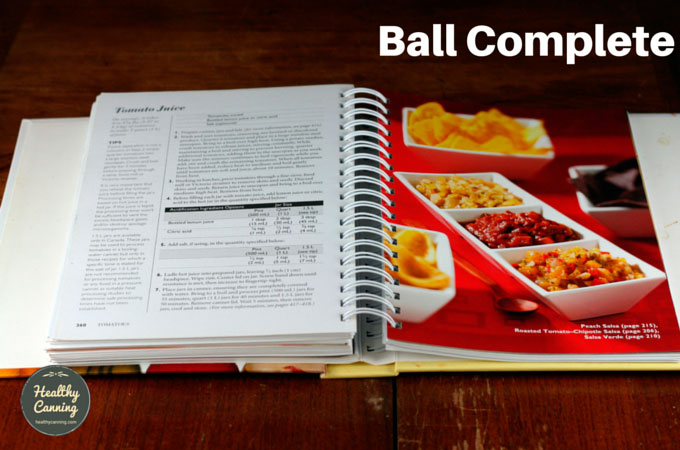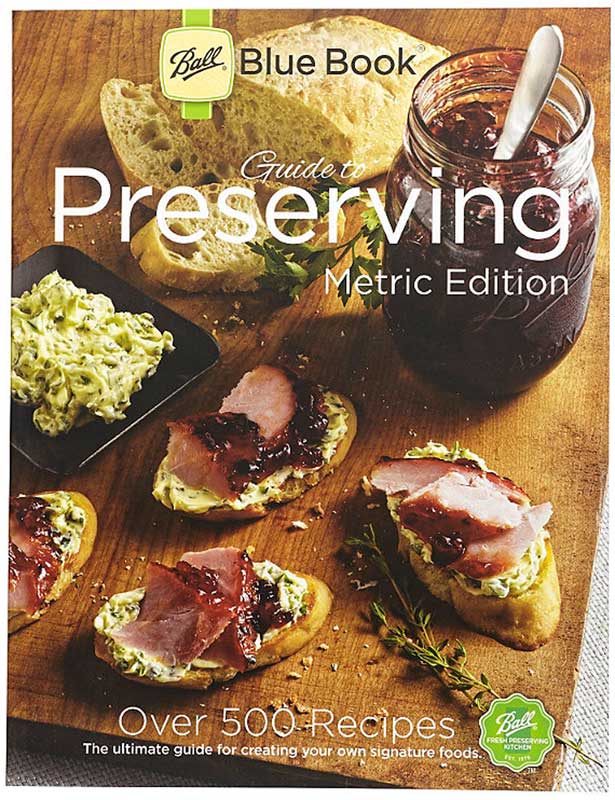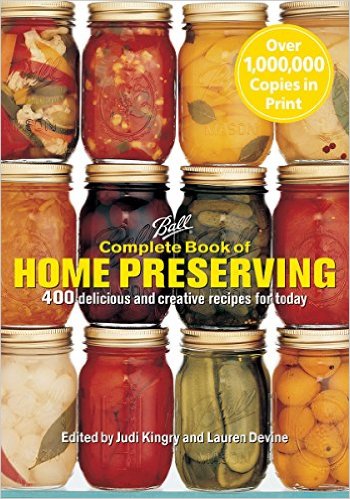Ball has been issuing a home canning book since 1909, starting with the Ball Blue Book. It has been a trusted private-sector name for the latest home canning guidance ever since.
It’s important to note that while you may cherish older editions that you or people in your family used, it is important to work from only the most recent editions so that the latest in home canning safety and quality gets incorporated into your home canning products.
As of summer 2016, there are three books in the Ball line-up for home canners.
All these books are relatively inexpensive.
1. Ball Blue Book;
2. Ball Complete Book of Home Preserving;
3. The All New Ball Book of Canning and Preserving
The above order reflects the order of expertise that the books address.
Tip! Remember that Amazon has a “look inside” feature on many books. Wherever you end up buying a book from, that is a great feature to let you see if a book appeals to you or not.
1. Ball Blue Book
The Blue Book was first published in 1909.
If you are a beginner canner looking at getting a Ball canning book, and don’t have their Blue Book yet, you may wish to get it. It has all the basics in a succinct fashion. And because it’s the thinnest book, it’s the easiest to flip through to find quick reference information on canning beans and other veg perfectly.
Even though it addresses basic canning, of all the Ball books it’s the one that experienced canners still reach for, for quick, no-nonsense processing information for pressure canning basics such as plain veg.
There are some photos, but not many.
There are 500 recipes in it, but they aren’t all canning recipes. That number includes recipes for freezing, and dehydrating, as well as recipes showing how to cook with your home canned products.
There’s an index at the back. Occasionally with some editions the index doesn’t always get fully updated — and fans usually let Ball know within days.
It’s perfect-bound, but because it’s thin, it will stay open easily.
Not many choices for alternative low-sugar or low-sodium canning.
Does not give nutritional information for recipes.
(Note: there’s no metric in this edition, only American volume measurements. If you want an edition that provides metric and weights, you need to search for the UK edition of this book, titled “Ball Blue Book® Guide – Metric Edition.” In the UK, it’s available at Lakeland stores, and on Ball’s UK website.)
It’s updated every few years. Each update is eagerly awaited by breathless fans.
As of time of writing this review in June 2016, the most current edition is: Ball Blue Book, 37th edition, 2014. Balls says, however, that the 36th edition from 2013 is still considered valid (as of 2016.)
Errata
Salsa Verde, page 36, simmering time should be 5 minutes.
Jalapeno salsa, page 36. Cider vinegar quantity should be 1 cup (250 ml), not ½ cup (125 ml) [1]Source: Ball Customer Service via Michelle Michaelis, October 2021. Quantity of vinegar should match that called for in the Ball / Bernardin Complete Book.
Hot Rhubarb Grilling Sauce, page 128. Missing processing time. Should be 10 minutes.
2. Ball Complete Book of Home Preserving
As you grow in canning you will want to expand your repertoire. This is where the Ball Complete comes in. It recaps a lot of what is in the Blue Book, and adds a lot more onto it.
The Ball Complete Book was first published in 2006. It is written in Canada.
The most recent version with a Ball cover is from 2012. Ball says there were just some “photo” updates. “The Ball Complete Book of Home Preserving was first published in 2006. Then in 2012 there were some updates to some of the images.” [2]Ball Facebook to Randal Oulton. 7 March 2018. The most recent edition with Bernardin on the cover is from 2015.
If it’s just canning recipes you care about, this book is a powerhouse for you. It has 400 recipes in it, and they are all canning. No curing or freezing, etc — all canning.
It doesn’t add any additional pressure canning recipes, but it does add a lot more water-bathing recipes. It has a few photo plates, but mostly is just a good old-style recipe book.
All the recipes are straightforward, though like many good old fashioned canning recipes, there can be a lot of chopping (hello, food processor) because you are starting from scratch.
It has a lot of helpful learning tips in the margin, and a very good index at the back. There’s also a 30 page learning and reference section at the back.
It’s bound in ring-binder format, so it stays open very easily either flat or standing up. The hard cover wipes clean easily.

The ring binding makes this book a pleasure to use. The hard cover wipes clean; there are a few photo plates. In the side margins are tips.
Not many choices for alternative low-sugar or low-sodium canning. In fact, there is a very heavy hand with white refined sugar.
No nutritional values are given.
Measurements are given in American and metric. Weights are occasionally but randomly given — note that the metric is the American faux metric that often gives solid ingredients measured in ml.
An identical separate version is published in Canada, with the Bernardin name on it.
It’s updated every few years.
The most current one, as of time of writing this review in June 2016, is the 2015 edition.
Errata list for Ball / Bernardin Complete
Tomatillo Salsa. 2015 edition, spiral bound, page 212. Calls for ½ cup (125 ml) vinegar. Emerie Brine from Bernardin in Dec 2016 says that appears to be a typo, should be 1 cup (250 ml) vinegar. (Correspondence on file.)
3. The All New Ball Book of Canning and Preserving
[Ed: Note that as of 2016 some University Extensions are expressing reservations about some recipes in the Ball All New book, and are unhappy with the response from Ball to their concerns. As a result, they are not teaching from this book. We share some of these reservations.
Any of the recipes that we work with on Healthy Canning are ones that we feel comfortable with from the book (note our suggestion that their Eggplant Pasta Sauce alla Puttanesca is probably best with citric acid added to it.)
We feel currently that a constructive role we can play in the conversation about this book is maintaining a list of concrete concerns, which is further below in the Errata section.]
As great as the Ball Blue and Ball Complete are, today’s experienced canners eventually hunger for a more challenging set of canning recipes with more interesting ingredients, and more cultural diversity, as well as a greater choice of pressure canning recipes.
This book, the ALL NEW, first released June 2016, is the book for them. Lots of ethnic and gourmet recipes, lots of all new pressure canning recipes for interesting dishes, lots of ingredients that haven’t appeared in Ball recipes before. And, Ball has caught up with the French side of its Canadian sister Bernardin and started to let the wine flow freely in the recipes. In this book, Ball has reached Gourmet Magazine levels.
Ball’s All New goes above and beyond the added variety that many experienced home canners have been pleading for from Ball for some years now.
If you’re bored with pressure canning the same old plain veg year after year, this book gives you loads of tips on how to tweak your veg with soy sauce, curry powder, and even balsamic syrup.

There are 5 pages of tables such as this giving you ideas of how to tweak your pressure canning classics to take them in new, delicious directions.
In terms of water-bathing recipes, Ball now rivals the gourmet-quality, Jarden-labs tested recipes available from Canadian Living (as well as the photos and layout.)
It catches Ball’s audience up with many techniques and tricks that were introduced by its sister Bernardin company a few years before, such as using dried chiles in recipes and roasting them before use for more flavour. (cf. “Grill or broil dried chilies, turning frequently, just until they start to char on all sides.” Bernardin Guide 2013, page 56.)
It will challenge experienced canners to really stretch their repertoires and minds.
Measurements are in American volume and metric, though the metric given is often the faux metric of liquid volume (e.g. 250 ml chopped onion) for solid ingredients.
When you do see weights given for produce, note that the weight is that of the pre-prep amount they want you to purchase, or start with. So, 3 ¾ lb (1.75) kg of pear indicates have that much weight of unpeeled, uncored pears before prep. [3]Confirmed with Ball via their Facebook page 23 July 2016. This can be very confusing, as they often also give volume weight equivalents for the same ingredients which are meant for after-prep. Consistency in thought process would have been appreciated here.
There are 350 recipes in the book but they are not all canning recipes: there’s also fermenting, freezing, curing, smoking and dehydrating, as well as sample usage recipes. Still, there’s enough new exciting canning recipes that canners will be more than satisfied.
There are not many choices for alternative low-sugar or low-sodium canning. Ball seems to be stuck in its addiction to sugar and salt. In this regard, the All New is very much the “Same Old”, with its heavy-handed application of refined white sugar, and tons of sodium flowing into people’s arteries. Ball’s Low or No-Sugar Pectin continues to be the red-headed step-child of Ball’s product line, with only 5 out of 25 jam recipes in the All New admitting its use.
No nutritional values are given.
One possible downside could be how the usage recipes are intermingled with the canning recipes. Without skipping straight to the bottom of a recipe and looking for that telltalle “processing time” direction, you sometimes don’t know if you have started to read a regular recipe or a canning recipe. Some kind of icon at the top of recipes, jar versus plate maybe, to indicate which it is might have been useful. But that’s a minor quibble.
It’s perfect bound, so you will probably need to put something on it to hold your page open until the spine gets broken in. Or, stand it up in a recipe book stand.
They’ve really done a great job with this book. The only thing is, it’s hard to know what they are going to call it when it’s not “new” anymore! :}
Here are some recipes from the book:
- Eggplant Pasta Sauce alla Puttanesca
- Pear and Sour Cherry Pie Filling
- Roasted Marinara Sauce
- Roasted Tomato Guajillo Salsa
- Salsa Roja
- Smoky Sour Cherry Pie Filling
- Vodka Pasta Sauce
Errata list for the All New Ball Book
Please let us know of any additions that should be made to this list that you know of.
- Roasted Eggplant and Pepper Puttanesca Sauce, page 181 (2016 edition). Add also: ½ cup (125 ml / 4 oz) of Balsamic vinegar and increase processing time from 35 minutes to 45 minutes. Ball made this correction quietly on their web site sometime before mid-October 2016. In a follow-up conversation with a Ball rep on Facebook, the rep said that the added acidity and processing time were optional “extra insurance.”
- UPDATE to Roasted Eggplant and Pepper Puttanesca Sauce, page 181 (2016 edition). Sometime in 2018, the “optional” on the ½ cup vinegar on their web site was dropped, now making it mandatory. Note that this has also had a taste impact and does result in a more vinegary tasting pasta sauce.
- Headspace converted incorrectly, “One Jar Meals” and “One Jar Vegetables”, page 274, 276: “.. leaving 1-inch (1-cm) headspace.” Should be 2.5 cm OR 3 cm, rounded.
- Cherry-Bourbon BBQ Sauce, page 184 (2016 edition). Headspace incorrectly given as ¼ inch (½ cm). The headspace should instead be ½ inch (1 cm) instead of just ¼ inch. This was caught by Lia Stern and confirmed to her by Ball — thanks to Lia for letting us know for our errata tracking:
There were also questions about some salsas (see below.)
Salsa recipes in the All New Ball Book
Many salsa recipes in this All New book use fresh as opposed to bottled lime juice. This is a departure for both Ball and the field of home canning. We’ve got a dedicated page on the fresh-lime juice salsas.
Eventually you may want all three Ball books. Even experienced canners just wanting to refresh their memories for processing times on a jar of plain mushrooms will always want a copy of the Ball Blue Book to hand, because its brevity is exactly what you want “in the heat of the moment.” But as you grow, you may get bored of the classic, core repertoire of what is in the Blue Book, and when you do, you may wish to get the other two Ball books.
4. Best Ball Home Canning and Preserving Recipes Magazine
This is a magazine / paperback format. Ball calls it a “bookazine.”
The 2016 edition contains a subset of recipes from the Ball All New; if you have the Ball All New, you already have all the recipes in here.
____________________
*Note that none of the three Ball books have more than a small handful of recipes for special dietary needs such as low-sugar or low-sodium (aside of course from the plain veg ones for pressure canning.) Nor do any of them provide nutritional information. Perhaps Ball will one day come out with a fourth book that allows its no-sugar needed pectin to finally have its day in the sun.
References













